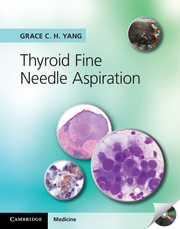Book contents
- Frontmatter
- Dedication
- Contents
- Preface
- 1 Techniques and approaches to ultrasound-guided fine needle aspiration
- 2 Nodular goiter and mimickers
- 3 Follicular neoplasm and mimickers
- 4 Hürthle cell neoplasm and mimickers
- 5 Follicular variant of papillary carcinoma
- 6 Thyroiditis and mimickers
- 7 Papillary thyroid carcinoma and variants with papillae and mimicker
- 8 Papillary thyroid carcinoma, uncommon variants, and mimicker
- 9 Clear cell and mucinous thyroid tumors
- 10 Poorly differentiated thyroid carcinoma
- 11 Anaplastic thyroid carcinoma
- 12 Medullary thyroid carcinoma
- 13 Miscellaneous benign lesions
- 14 Metastatic thyroid carcinoma
- 15 Metastatic and secondary tumors to the thyroid
- 16 Ancillary tests
- Index to case histories
- Index to ultrasound and Doppler images
- General index
- References
4 - Hürthle cell neoplasm and mimickers
Published online by Cambridge University Press: 05 September 2014
- Frontmatter
- Dedication
- Contents
- Preface
- 1 Techniques and approaches to ultrasound-guided fine needle aspiration
- 2 Nodular goiter and mimickers
- 3 Follicular neoplasm and mimickers
- 4 Hürthle cell neoplasm and mimickers
- 5 Follicular variant of papillary carcinoma
- 6 Thyroiditis and mimickers
- 7 Papillary thyroid carcinoma and variants with papillae and mimicker
- 8 Papillary thyroid carcinoma, uncommon variants, and mimicker
- 9 Clear cell and mucinous thyroid tumors
- 10 Poorly differentiated thyroid carcinoma
- 11 Anaplastic thyroid carcinoma
- 12 Medullary thyroid carcinoma
- 13 Miscellaneous benign lesions
- 14 Metastatic thyroid carcinoma
- 15 Metastatic and secondary tumors to the thyroid
- 16 Ancillary tests
- Index to case histories
- Index to ultrasound and Doppler images
- General index
- References
- Type
- Chapter
- Information
- Thyroid Fine Needle Aspiration , pp. 90 - 154Publisher: Cambridge University PressPrint publication year: 2013

